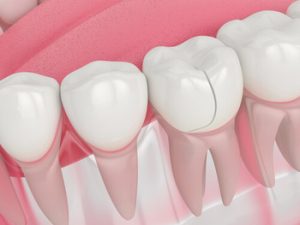Broken Tooth Filling Solutions – Restore Your Smile

Experiencing a broken or chipped tooth can be alarming and painful. Tooth decay or physical accidents often lead to damaged teeth, requiring immediate attention.
While some might fear a surgical or invasive procedure, a simple dental filling can address many of these dental emergencies.
Dental fillings are a primary solution to restore the structure and function of the affected tooth.
Whether it’s minor cracked teeth or a more noticeable chipped front tooth, understanding the significance of tooth filling can save your natural tooth from further damage or more invasive treatments.
Always consult an appropriately qualified health practitioner for precise treatment services.
Causes of Broken Teeth
A broken tooth is a common dental emergency, often resulting from various factors that compromise the integrity of our teeth.
One of the primary culprits behind a chipped or broken tooth is accidents. Whether it’s a fall, sports-related injury, or an unexpected blow to the mouth, these unforeseen incidents can lead to damaged teeth in a split second.
Besides accidental injuries, indulging in hard foods can lead to a cracked tooth or tooth decay.
Biting down on ice, hard candy, or non-food items frequently challenges our natural tooth strength and can cause them to chip or break.
This is especially true if the tooth already has a weakened structure due to dental issues.
Tooth decay, resulting from gum disease or the gradual buildup of plaque, can weaken a tooth to the point where it becomes prone to breakage. Over time, decayed teeth might require more than just a dental filling; a root canal or dental crown might become necessary to save the affected tooth.
Lastly, natural wear and tear on our teeth, as we age, make them more susceptible to fractures. If untreated, the consistent grinding of teeth can lead to a fractured tooth at or below the gum line, emphasising the importance of regular dentist appointments and preventive measures like a mouth guard. Suppose you suspect a broken tooth or any form of dental damage.
In that case, seeking treatment services from an experienced dentist as soon as possible is essential to prevent further damage and complications.
What is a Filling?
 When a tooth becomes compromised due to decay, a fracture, or a chip, a dental filling offers a rescue route. Dental fillings are specially designed treatments for restoring the integrity and function of an affected tooth without needing a more invasive procedure like a root canal or tooth extraction.
When a tooth becomes compromised due to decay, a fracture, or a chip, a dental filling offers a rescue route. Dental fillings are specially designed treatments for restoring the integrity and function of an affected tooth without needing a more invasive procedure like a root canal or tooth extraction.
The primary purpose of a tooth filling is to fill the void or damage in the tooth, preventing further tooth decay or complications. Two of the most common filling materials are composite and amalgam. Composite resin fillings are tooth-coloured and blend seamlessly with the natural appearance of your teeth, making them a popular choice for patients seeking discretion, especially for front teeth.
Amalgam Fillings
On the other hand, amalgam fillings are silver-coloured and made from a mixture of metals. Though less aesthetic, they’re durable and long-lasting, often recommended for molars. An experienced dentist will usually assess the extent of tooth damage, decay, or wear and then recommend the most appropriate type of filling. It’s vital to promptly address a broken or chipped tooth, as ignoring it might lead to more complicated dental emergencies.
Regular dentist appointments help early detection, ensuring your real teeth stay strong and intact for as long as possible.
Process of Filling a Broken Tooth
Step-By-Step Breakdown
Encountering a broken or chipped tooth can be discomforting. Still, with advancements in dentistry, addressing such concerns through a broken tooth filling has become efficient and minimally invasive.
Here’s a step-by-step breakdown of how dental professionals tackle damaged teeth with fillings:
Examination
When you make a dentist appointment, an experienced dentist will first thoroughly examine the affected tooth.
Utilising modern imaging technology, they will assess the extent of damage or decay, ensuring that a dental filling is indeed the appropriate solution.
A root canal treatment or dental crown might be suggested for extensive damage.
Cleaning
Before proceeding with the tooth filling, the dental team ensures the tooth is free from decay, debris, or bacteria. This is crucial, as any residue can lead to further tooth decay or complications.
Filling Placement
Depending on the examination results and patient preferences, the chosen filling material, be it composite resin or amalgam, is then meticulously placed in the cavity or crack.
The material is shaped to resemble the natural contour of the tooth, restoring its function and aesthetics.
Aftercare
The dentist will guide aftercare once the dental filling is in place.
This usually involves avoiding extremely hard or sticky foods for a short period, maintaining oral hygiene, and possibly scheduling a follow-up visit.
If the tooth hurts post-procedure, over-the-counter medications are typically recommended.
It’s essential to act swiftly when faced with a dental emergency like a chipped tooth or cracked tooth.
Prompt intervention alleviates pain and prevents the situation from escalating into more complex dental emergencies requiring more invasive procedures.
Benefits of Using Fillings
The moment we encounter a chipped or broken tooth, a whirlwind of concerns emerges – from the pain to the unsightly gap in our smile.
Fortunately, dental fillings offer a myriad of benefits to address these concerns:
Restoration of Function
One of the primary advantages of a tooth filling is restoring the tooth’s natural function.
A broken tooth can make daily activities like chewing and speaking uncomfortable or painful.
With the precise placement of dental fillings, you can confidently eat, speak, and smile without discomfort or fear of causing further damage to the tooth.
Prevention of Further Damage
An untreated damaged tooth can open up to more severe problems, including infections, further tooth decay, or even the need for a root canal treatment.
A dental filling acts as a protective barrier, sealing off any vulnerabilities and ensuring the longevity of your permanent teeth.
Conclusion
 Our teeth play an invaluable role in our daily lives, from aiding digestion to sculpting our smiles.
Our teeth play an invaluable role in our daily lives, from aiding digestion to sculpting our smiles.
The onset of problems like a chipped or broken tooth, tooth decay, or a cracked tooth can significantly hinder our comfort and confidence.
However, with the advancements in dental technology, solutions like dental fillings offer an effective way to rectify such issues without resorting to a more surgical or invasive procedure.
The essence of timely intervention cannot be emphasised enough. Addressing issues like a broken tooth or tooth decay at the earliest prevents further damage and saves you from complicated treatments down the line.
Having an experienced dentist evaluate the condition of your damaged teeth ensures you receive the best possible care.
And if you’re searching for an appropriately qualified health practitioner to cater to your dental emergencies, look no further than My Local Dentists.
Our dedicated dental team is at the forefront of providing top-tier treatment services, ensuring the health and vibrancy of your real teeth.
If you’ve recently experienced a dental emergency or suspect any anomalies with your teeth, don’t hesitate. Call us at (02) 9809 7000 and let My Local Dentists be your partner in preserving that precious smile. Your oral health deserves the best; we’re here to provide just that.
Note: Any surgical or invasive procedure carries risks. Before proceeding, you should seek a second opinion from an appropriately qualified health practitioner.
References:
https://www.webmd.com/oral-health/guide/dental-health-fillings
https://www.healthline.com/health/how-long-do-fillings-last
